
SoM-LLaVA
Empowering Multimodal LLMs with Set-of-Mark Prompting and Improved Visual Reasoning Ability.
Stars: 92
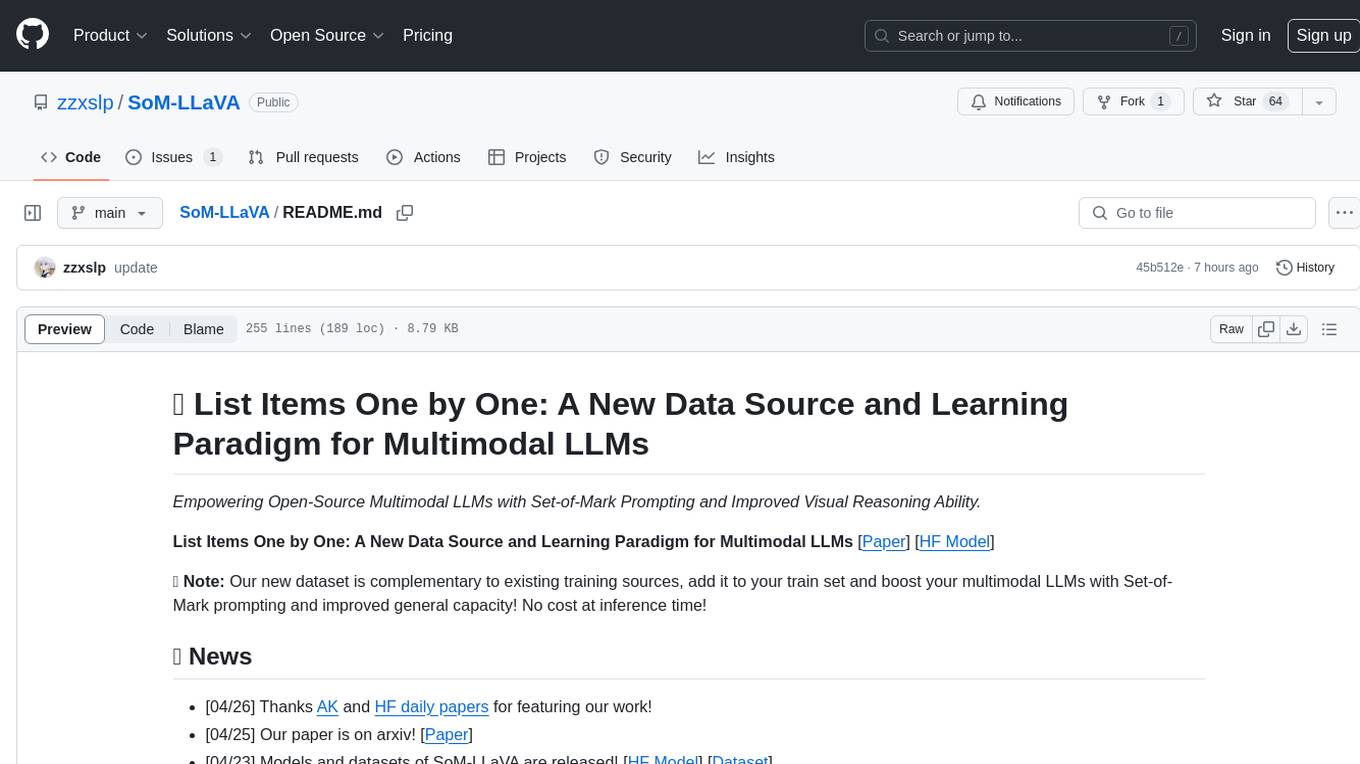
SoM-LLaVA is a new data source and learning paradigm for Multimodal LLMs, empowering open-source Multimodal LLMs with Set-of-Mark prompting and improved visual reasoning ability. The repository provides a new dataset that is complementary to existing training sources, enhancing multimodal LLMs with Set-of-Mark prompting and improved general capacity. By adding 30k SoM data to the visual instruction tuning stage of LLaVA, the tool achieves 1% to 6% relative improvements on all benchmarks. Users can train SoM-LLaVA via command line and utilize the implementation to annotate COCO images with SoM. Additionally, the tool can be loaded in Huggingface for further usage.
README:
Empowering Open-Source Multimodal LLMs with Set-of-Mark Prompting and Improved Visual Reasoning Ability.
List Items One by One: A New Data Source and Learning Paradigm for Multimodal LLMs [Paper] [HF Model]
📣 Note: Our new dataset is complementary to existing training sources, add it to your train set and boost your multimodal LLMs with Set-of-Mark prompting and improved general capacity! No cost at inference time!
- [07/10] Our paper is accepted at COLM-2024, see you in Philly!
- [04/26] Thanks AK and HF daily papers for featuring our work!
- [04/25] Our paper is on arxiv! [Paper]
- [04/23] Models and datasets of SoM-LLaVA are released! [HF Model] [Dataset]
| Method | LLM | POPE | MME | SEED-I | LLaVA-Wild | MM-VET |
| BLIP-2 | Vicuna-13B | 85.3 | 1293.8 | 49.7 | 38.1 | 22.4 |
| LLaVA-1.5 | Vicuna-13B | 85.9 | 1531.3 | 68.2 | 70.7 | 35.4 |
| SoM-LLaVA-1.5 | Vicuna-13B | 86.6 | 1563.1 | 69.6 | 75.3 | 35.9 |
| SoM-LLaVA-1.5 w/ tags | Vicuna-13B | 87.0 | 1572.8 | 69.5 | 73.3 | 37.2 |
📣 Note: We get 1% to 6% relative improvements on all benchmarks, by simply adding 30k SoM data to the visual instruction tuning stage of LLaVA. SoM-LLaVA-1.5 w/ tags is to feed the model with tagged images, but you can enjoy the performance gain even without the extra visual prompts at test time!
som_llava_mix695k.json: Full SFT data with llava-665k + SoM-30k
som_listing_coco10k.json: listing all items with SoM images.
som_qa_coco20k.json: QA with SoM images. (Note: QA used the same 10k images from listing, with another batch of 10k added.)
som_train2017.zip: A subset of 20k coco images that is annotated with SoM, used in our data construction.
We release our main model, SoM-LLaVA trained with LLaVA-665k and SoM-style Listing + QA data.
[SoM-LLaVA-v1.5-13B] (model weights in original LLaVA format, load and eval with LLaVA)
[SoM-LLaVA-v1.5-13B-HF] (model weights converted into HF format, see usage below)
Two additional models for ablation study:
We adopt the training code of LLaVA. Please set up environments following the instructions. Currently our data is used in the Visual Instruction Tuning stage.
- Prepare data
Please download the annotation of the final mixture of our instruction tuning data som_llava_mix695k.json , which is a mixture of llava_mix665k and 30k SoM data, and download the images from the following datasets:
- COCO: train2017
- COCO: som_train2017
- GQA: images
- OCR-VQA: download script, we save all files as
.jpg - TextVQA: train_val_images
- VisualGenome: part1, part2
After downloading all of them, organize the data as follows in your data folder.
├── coco
│ ├── train2017
│ └── som_train2017
├── gqa
│ └── images
├── ocr_vqa
│ └── images
├── textvqa
│ └── train_images
└── vg
├── VG_100K
└── VG_100K_2
- Training
After downloading our data (or preparing your own SoM data), train SoM-LLaVA via command line:
bash scripts/v1_5/finetune.sh
Note: Our implementation is improved over the original SoM repo, by removing overlapping regions for each mask (otherwise there will be confilicts/overlaps for tag positions).
- Init virtual envs
# create env. Note: must use 3.10, 3.11 will cause package conflicts.
conda create -n som python=3.10 -y
conda activate som
- Install libgeos if there is error installing SEEM
sudo apt-get update
sudo apt-get install libgeos-c1v5 libgeos-dev
- Install segmentation packages
# download repo and navigate to SoM folder
git clone https://github.com/zzxslp/SoM-LLaVA.git
cd ~/SoM-LLaVA/SoM/
# install PyTorch
pip3 install torch torchvision torchaudio
# install SEEM
pip install git+https://github.com/UX-Decoder/Segment-Everything-Everywhere-All-At-Once.git@package
# install SAM
pip install git+https://github.com/facebookresearch/segment-anything.git
# install Semantic-SAM
pip install git+https://github.com/UX-Decoder/Semantic-SAM.git@package
# install Deformable Convolution for Semantic-SAM
cd ops && sh make.sh && cd ..
# common error fix:
python -m pip install 'git+https://github.com/MaureenZOU/detectron2-xyz.git'
# install additional packages
pip install datasets- Download the pretrained models
sh download_ckpt.sh- Annotate COCO images with SoM
python annotate_coco.pyIf you would like to load our model in huggingface, here is an example script:
from PIL import Image
import requests
from transformers import AutoProcessor, LlavaForConditionalGeneration
model_path = "zzxslp/som-llava-v1.5-13b-hf"
model = LlavaForConditionalGeneration.from_pretrained(model_path)
processor = AutoProcessor.from_pretrained(model_path)
prompt = "USER: <image>\nWhat's the content of the image? ASSISTANT:"
url = "https://www.ilankelman.org/stopsigns/australia.jpg"
image = Image.open(requests.get(url, stream=True).raw)
inputs = processor(text=prompt, images=image, return_tensors="pt")
# Generate
generate_ids = model.generate(**inputs, max_new_tokens=20)
output = processor.batch_decode(generate_ids, skip_special_tokens=True, clean_up_tokenization_spaces=False)[0]
print (output)Note: to reproduce the results reported in the paper, we recommend using the official LLaVA repo with our LLaVA-format model.
If you find our data or model useful for your research and applications, please cite our paper:
@article{yan2024list,
title={List Items One by One: A New Data Source and Learning Paradigm for Multimodal LLMs},
author={Yan, An and Yang, Zhengyuan and Wu, Junda and Zhu, Wanrong and Yang, Jianwei and Li, Linjie and Lin, Kevin and Wang, Jianfeng and McAuley, Julian and Gao, Jianfeng and others},
journal={arXiv preprint arXiv:2404.16375},
year={2024}
}
This project is a collaborative work between UC San Diego and Microsoft GenAI, built on top of LLaVA and SoM. Thank the authors for their contributions to the community!
For Tasks:
Click tags to check more tools for each tasksFor Jobs:
Alternative AI tools for SoM-LLaVA
Similar Open Source Tools

SoM-LLaVA
SoM-LLaVA is a new data source and learning paradigm for Multimodal LLMs, empowering open-source Multimodal LLMs with Set-of-Mark prompting and improved visual reasoning ability. The repository provides a new dataset that is complementary to existing training sources, enhancing multimodal LLMs with Set-of-Mark prompting and improved general capacity. By adding 30k SoM data to the visual instruction tuning stage of LLaVA, the tool achieves 1% to 6% relative improvements on all benchmarks. Users can train SoM-LLaVA via command line and utilize the implementation to annotate COCO images with SoM. Additionally, the tool can be loaded in Huggingface for further usage.
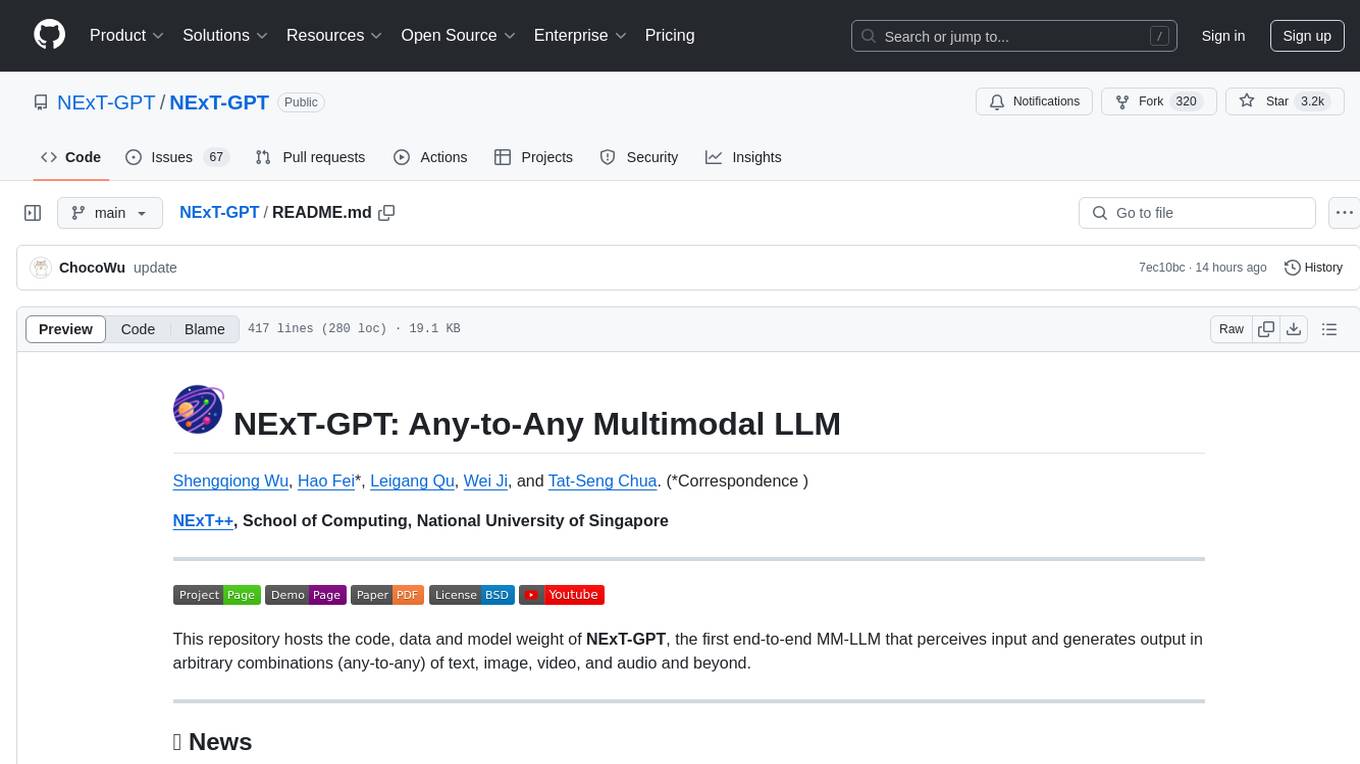
NExT-GPT
NExT-GPT is an end-to-end multimodal large language model that can process input and generate output in various combinations of text, image, video, and audio. It leverages existing pre-trained models and diffusion models with end-to-end instruction tuning. The repository contains code, data, and model weights for NExT-GPT, allowing users to work with different modalities and perform tasks like encoding, understanding, reasoning, and generating multimodal content.
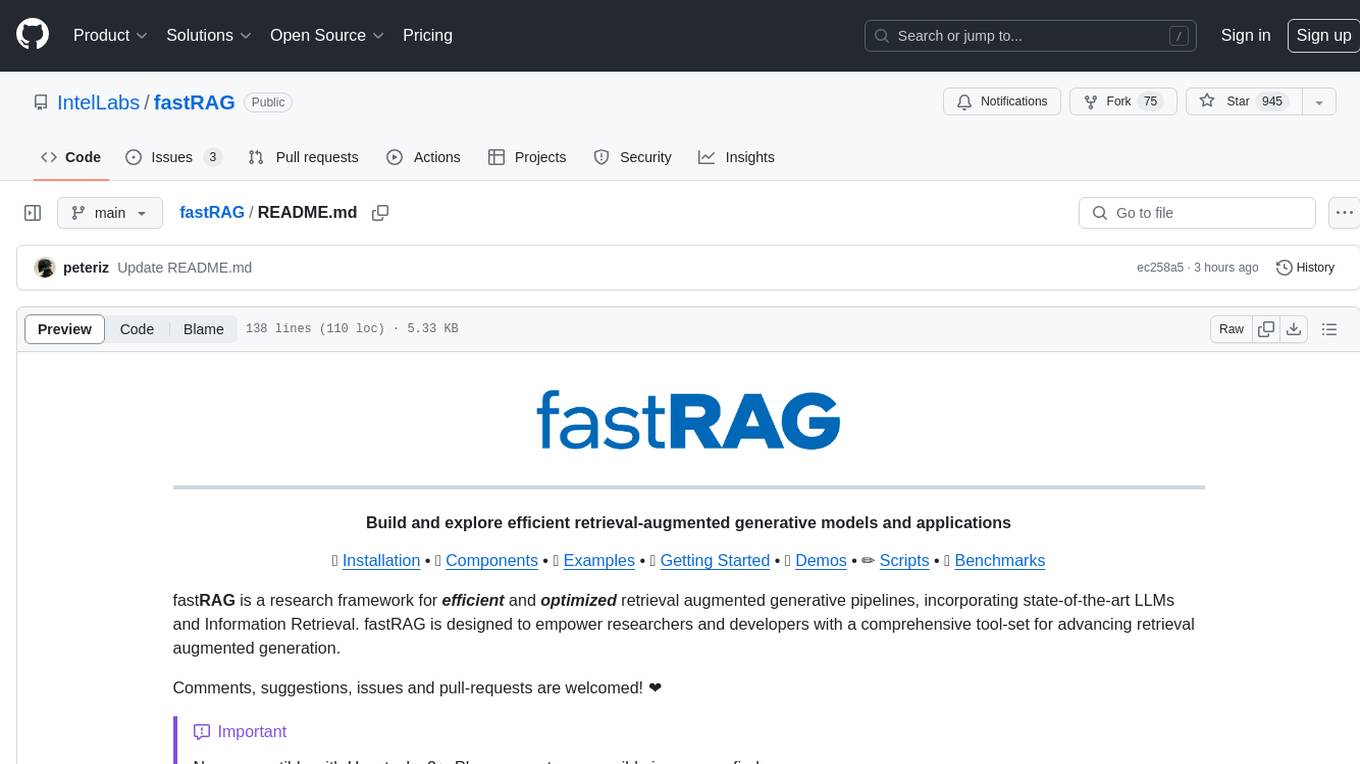
fastRAG
fastRAG is a research framework designed to build and explore efficient retrieval-augmented generative models. It incorporates state-of-the-art Large Language Models (LLMs) and Information Retrieval to empower researchers and developers with a comprehensive tool-set for advancing retrieval augmented generation. The framework is optimized for Intel hardware, customizable, and includes key features such as optimized RAG pipelines, efficient components, and RAG-efficient components like ColBERT and Fusion-in-Decoder (FiD). fastRAG supports various unique components and backends for running LLMs, making it a versatile tool for research and development in the field of retrieval-augmented generation.
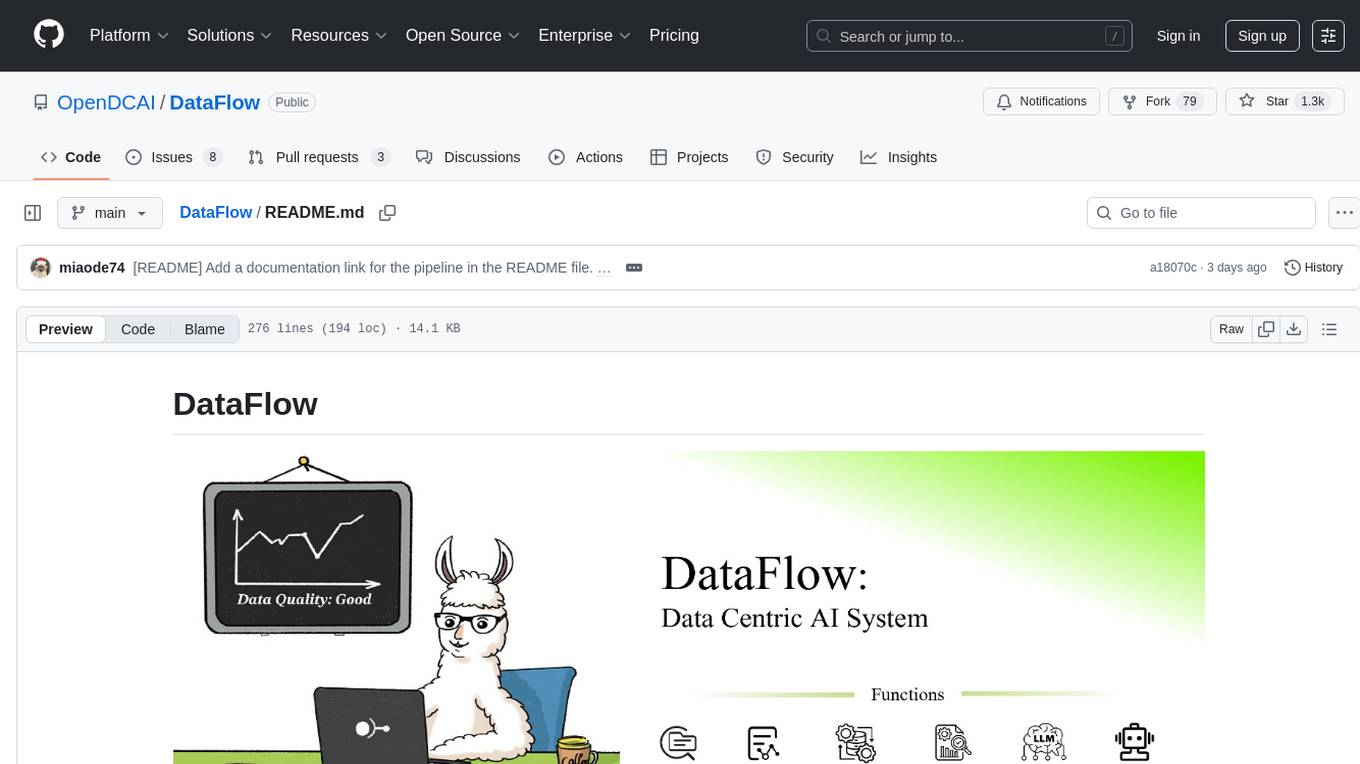
DataFlow
DataFlow is a data preparation and training system designed to parse, generate, process, and evaluate high-quality data from noisy sources, improving the performance of large language models in specific domains. It constructs diverse operators and pipelines, validated to enhance domain-oriented LLM's performance in fields like healthcare, finance, and law. DataFlow also features an intelligent DataFlow-agent capable of dynamically assembling new pipelines by recombining existing operators on demand.
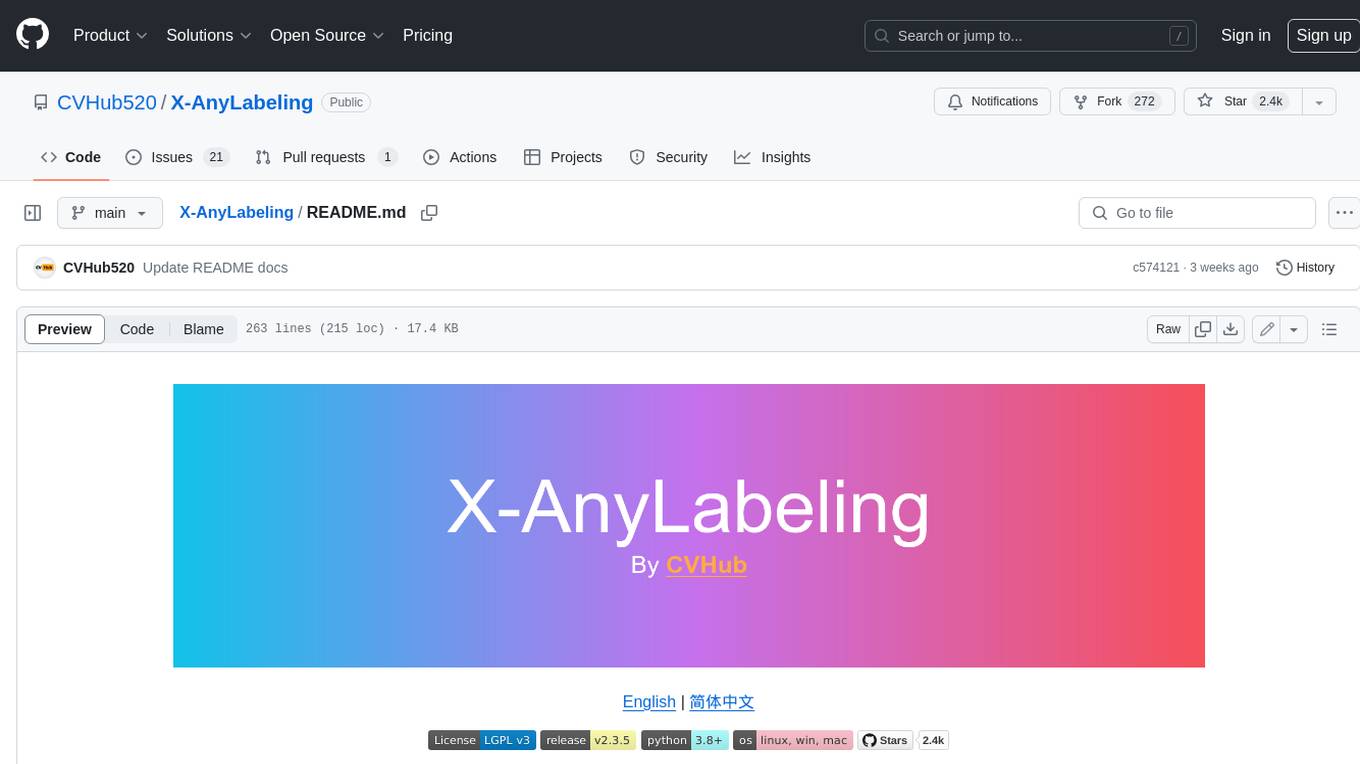
X-AnyLabeling
X-AnyLabeling is a robust annotation tool that seamlessly incorporates an AI inference engine alongside an array of sophisticated features. Tailored for practical applications, it is committed to delivering comprehensive, industrial-grade solutions for image data engineers. This tool excels in swiftly and automatically executing annotations across diverse and intricate tasks.
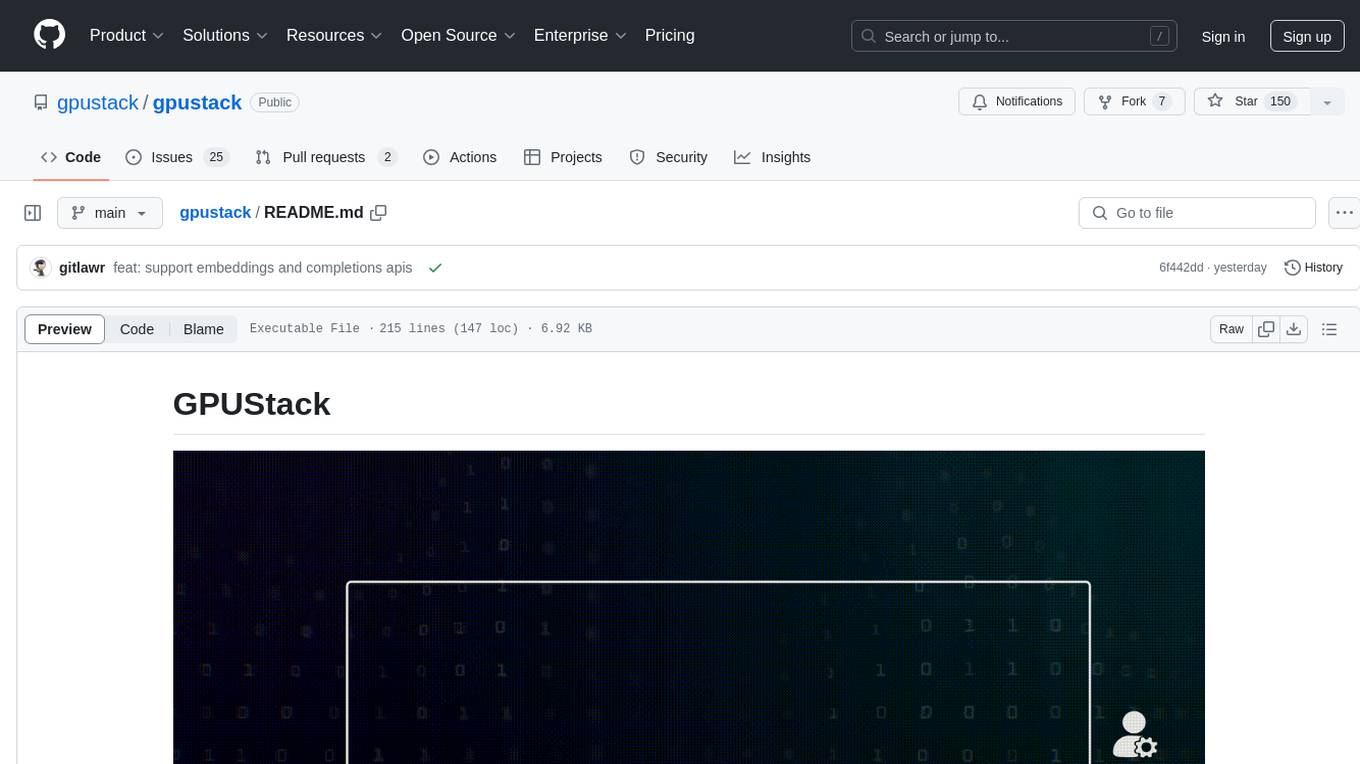
gpustack
GPUStack is an open-source GPU cluster manager designed for running large language models (LLMs). It supports a wide variety of hardware, scales with GPU inventory, offers lightweight Python package with minimal dependencies, provides OpenAI-compatible APIs, simplifies user and API key management, enables GPU metrics monitoring, and facilitates token usage and rate metrics tracking. The tool is suitable for managing GPU clusters efficiently and effectively.
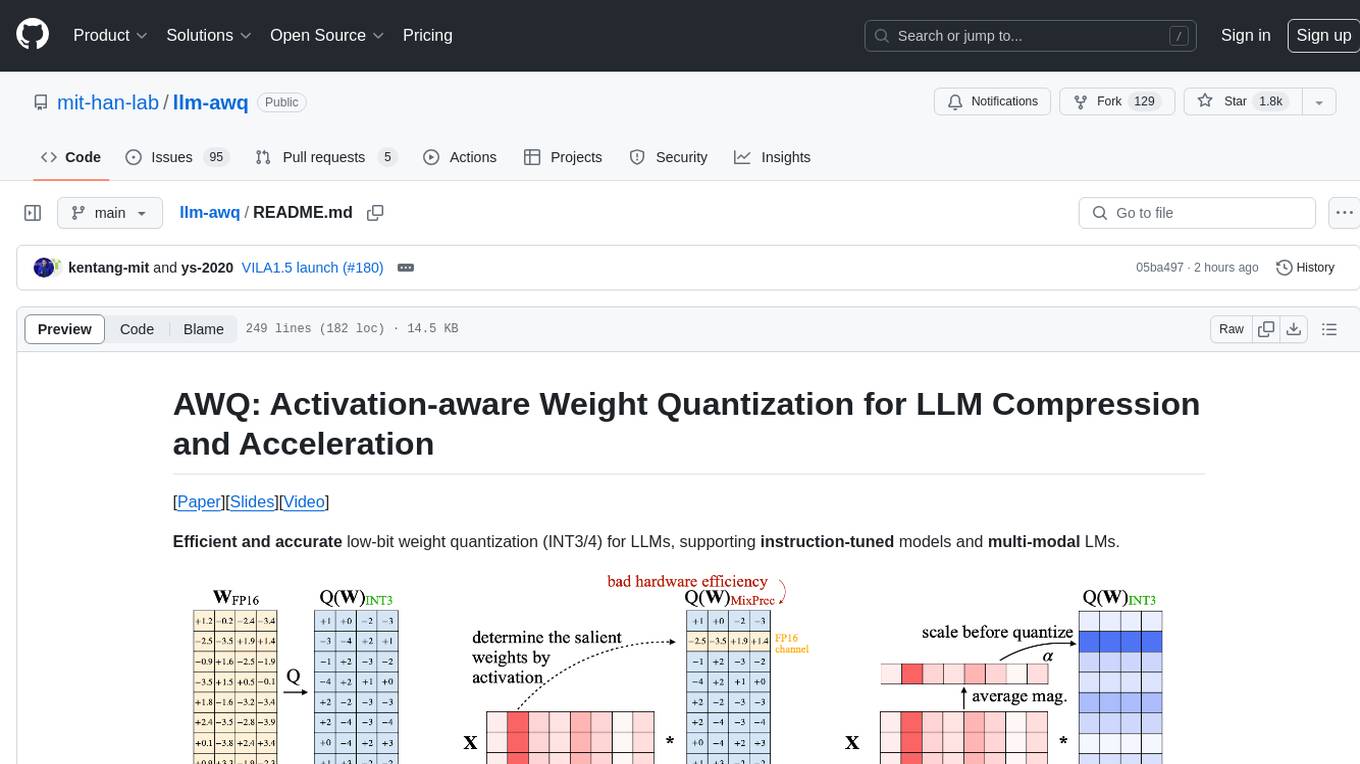
llm-awq
AWQ (Activation-aware Weight Quantization) is a tool designed for efficient and accurate low-bit weight quantization (INT3/4) for Large Language Models (LLMs). It supports instruction-tuned models and multi-modal LMs, providing features such as AWQ search for accurate quantization, pre-computed AWQ model zoo for various LLMs, memory-efficient 4-bit linear in PyTorch, and efficient CUDA kernel implementation for fast inference. The tool enables users to run large models on resource-constrained edge platforms, delivering more efficient responses with LLM/VLM chatbots through 4-bit inference.

WeKnora
WeKnora is a document understanding and semantic retrieval framework based on large language models (LLM), designed specifically for scenarios with complex structures and heterogeneous content. The framework adopts a modular architecture, integrating multimodal preprocessing, semantic vector indexing, intelligent recall, and large model generation reasoning to build an efficient and controllable document question-answering process. The core retrieval process is based on the RAG (Retrieval-Augmented Generation) mechanism, combining context-relevant segments with language models to achieve higher-quality semantic answers. It supports various document formats, intelligent inference, flexible extension, efficient retrieval, ease of use, and security and control. Suitable for enterprise knowledge management, scientific literature analysis, product technical support, legal compliance review, and medical knowledge assistance.
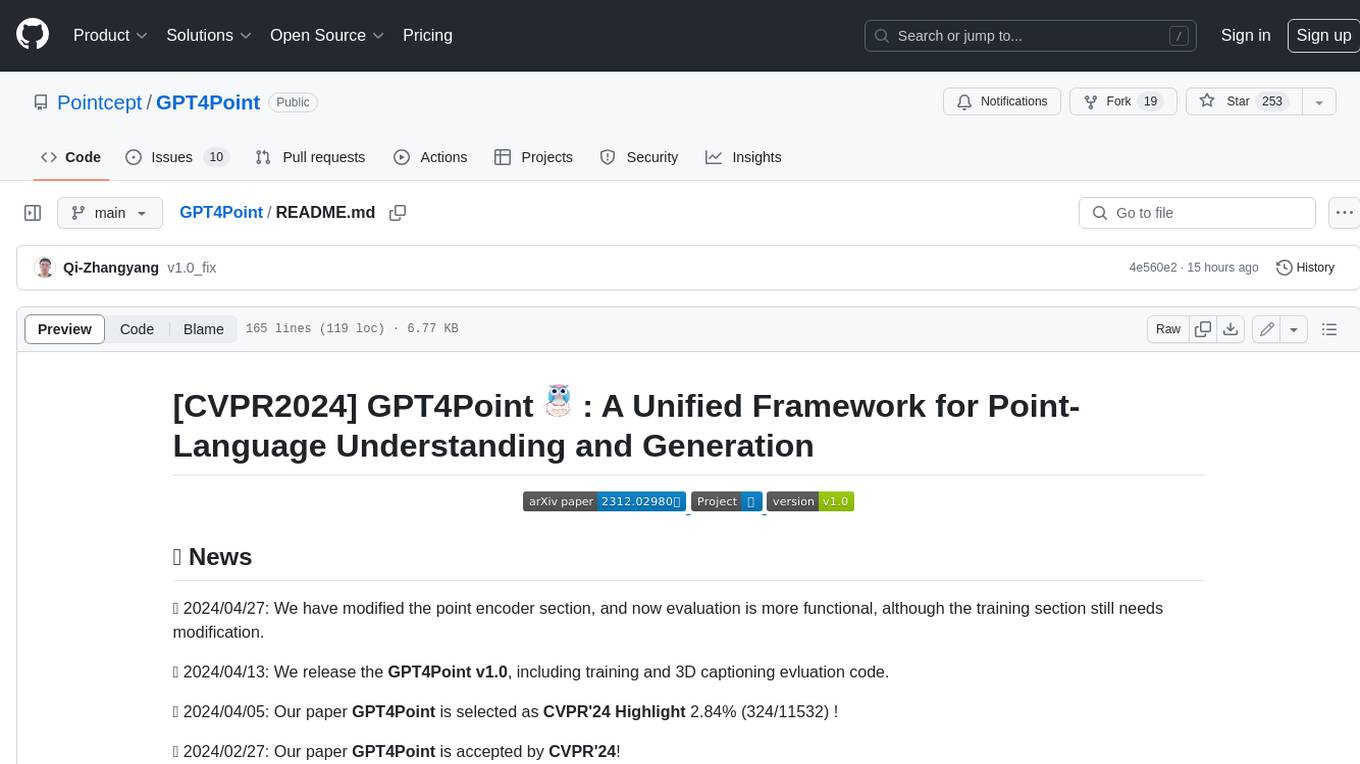
GPT4Point
GPT4Point is a unified framework for point-language understanding and generation. It aligns 3D point clouds with language, providing a comprehensive solution for tasks such as 3D captioning and controlled 3D generation. The project includes an automated point-language dataset annotation engine, a novel object-level point cloud benchmark, and a 3D multi-modality model. Users can train and evaluate models using the provided code and datasets, with a focus on improving models' understanding capabilities and facilitating the generation of 3D objects.
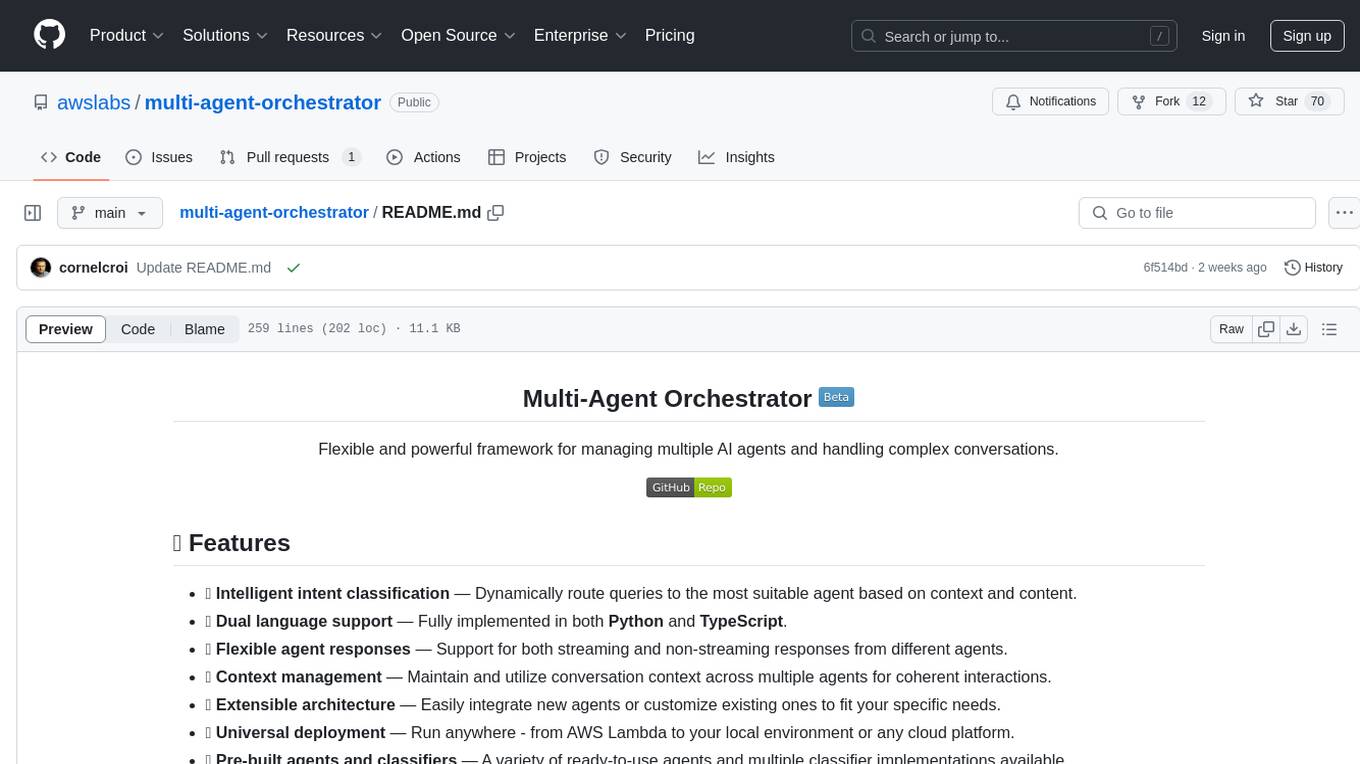
multi-agent-orchestrator
Multi-Agent Orchestrator is a flexible and powerful framework for managing multiple AI agents and handling complex conversations. It intelligently routes queries to the most suitable agent based on context and content, supports dual language implementation in Python and TypeScript, offers flexible agent responses, context management across agents, extensible architecture for customization, universal deployment options, and pre-built agents and classifiers. It is suitable for various applications, from simple chatbots to sophisticated AI systems, accommodating diverse requirements and scaling efficiently.
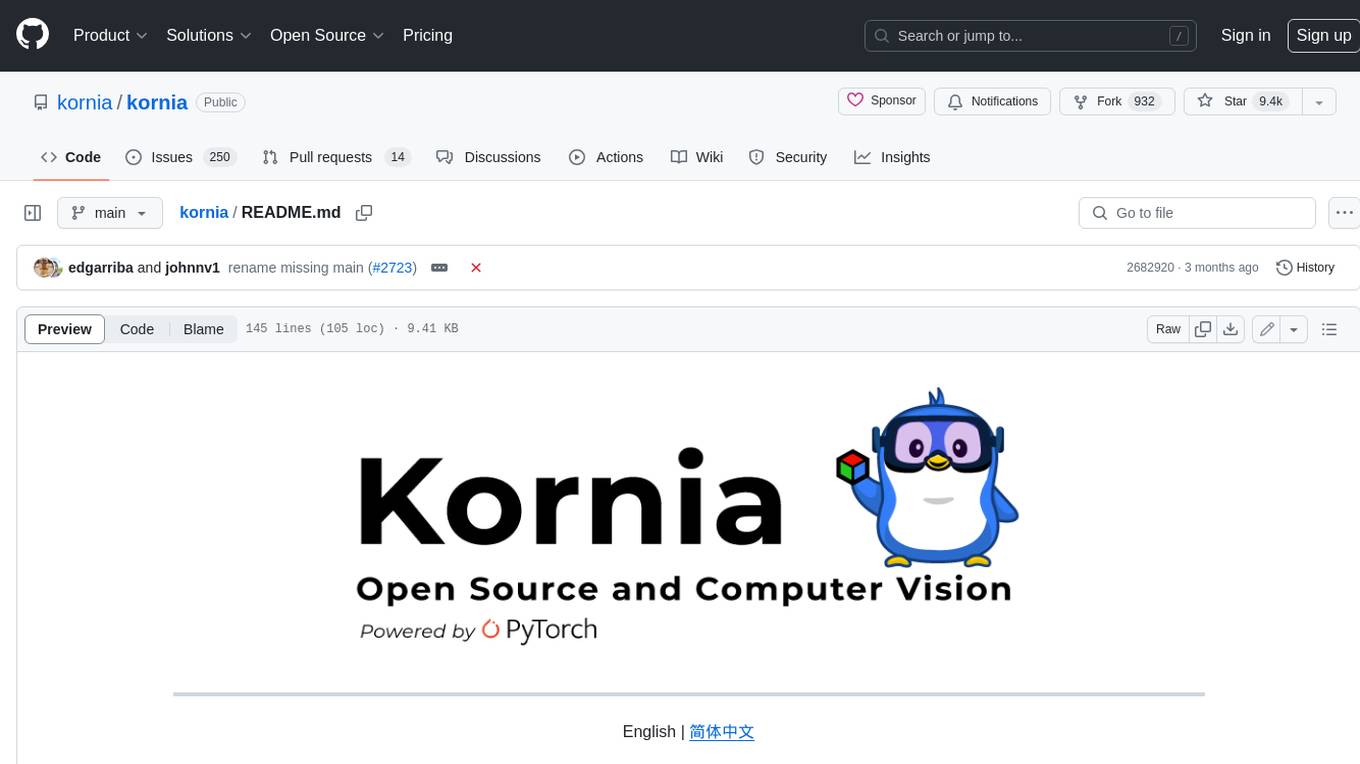
kornia
Kornia is a differentiable computer vision library for PyTorch. It consists of a set of routines and differentiable modules to solve generic computer vision problems. At its core, the package uses PyTorch as its main backend both for efficiency and to take advantage of the reverse-mode auto-differentiation to define and compute the gradient of complex functions.
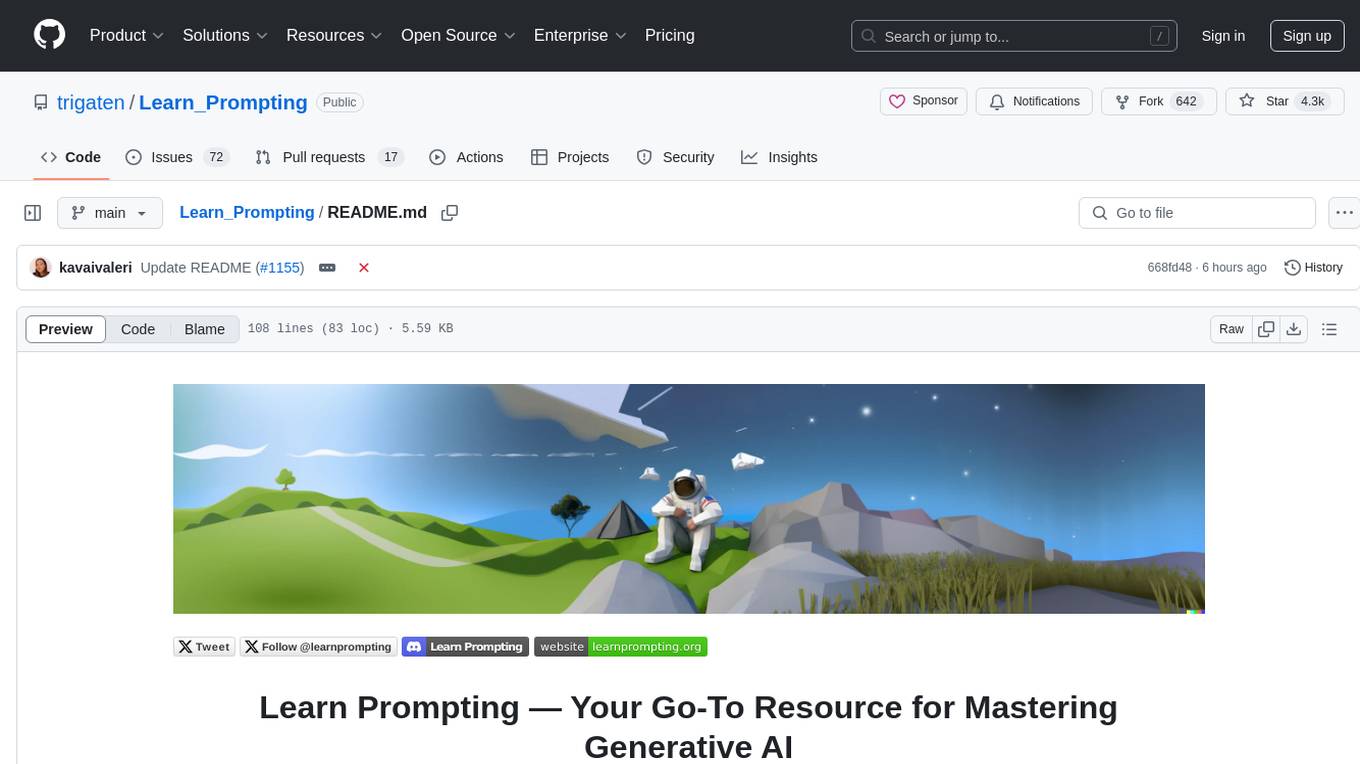
Learn_Prompting
Learn Prompting is a platform offering free resources, courses, and webinars to master prompt engineering and generative AI. It provides a Prompt Engineering Guide, courses on Generative AI, workshops, and the HackAPrompt competition. The platform also offers AI Red Teaming and AI Safety courses, research reports on prompting techniques, and welcomes contributions in various forms such as content suggestions, translations, artwork, and typo fixes. Users can locally develop the website using Visual Studio Code, Git, and Node.js, and run it in development mode to preview changes.
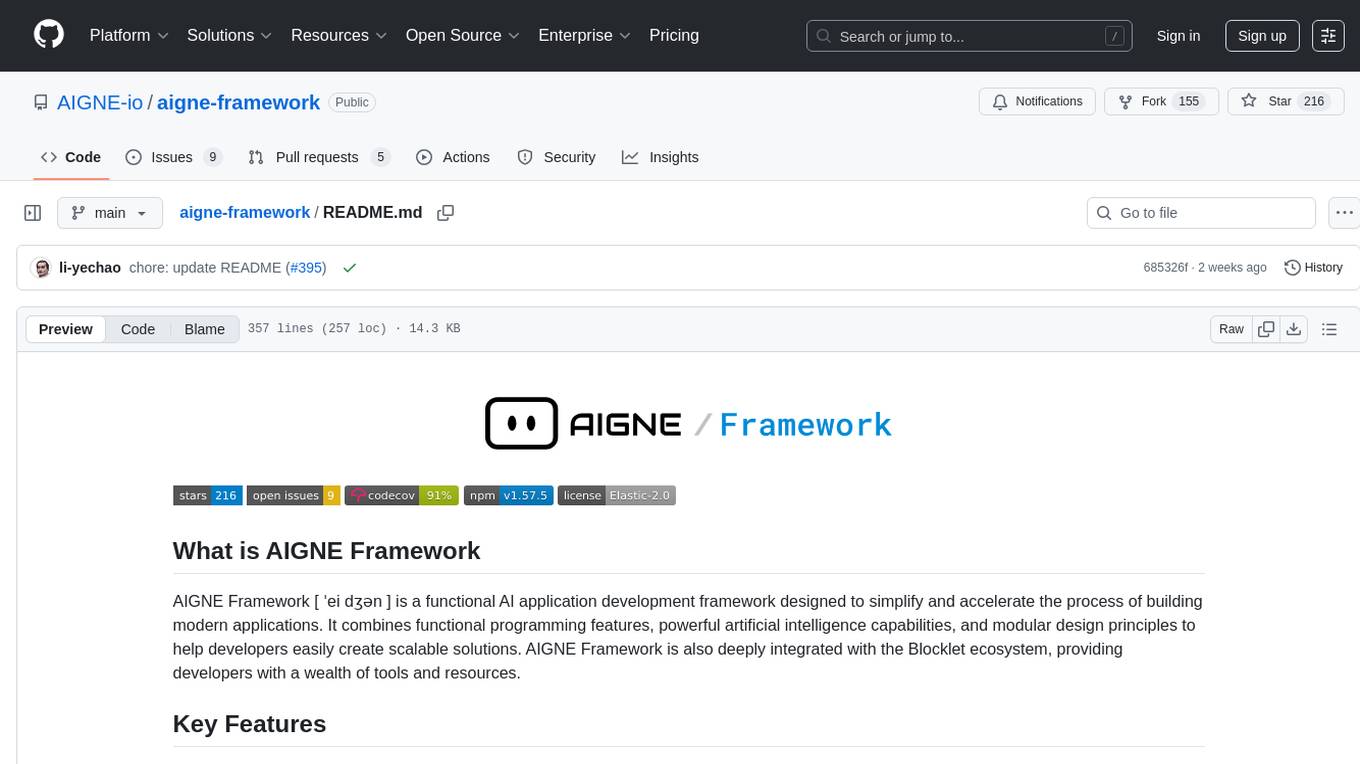
aigne-framework
AIGNE Framework is a functional AI application development framework designed to simplify and accelerate the process of building modern applications. It combines functional programming features, powerful artificial intelligence capabilities, and modular design principles to help developers easily create scalable solutions. With key features like modular design, TypeScript support, multiple AI model support, flexible workflow patterns, MCP protocol integration, code execution capabilities, and Blocklet ecosystem integration, AIGNE Framework offers a comprehensive solution for developers. The framework provides various workflow patterns such as Workflow Router, Workflow Sequential, Workflow Concurrency, Workflow Handoff, Workflow Reflection, Workflow Orchestration, Workflow Code Execution, and Workflow Group Chat to address different application scenarios efficiently. It also includes built-in MCP support for running MCP servers and integrating with external MCP servers, along with packages for core functionality, agent library, CLI, and various models like OpenAI, Gemini, Claude, and Nova.
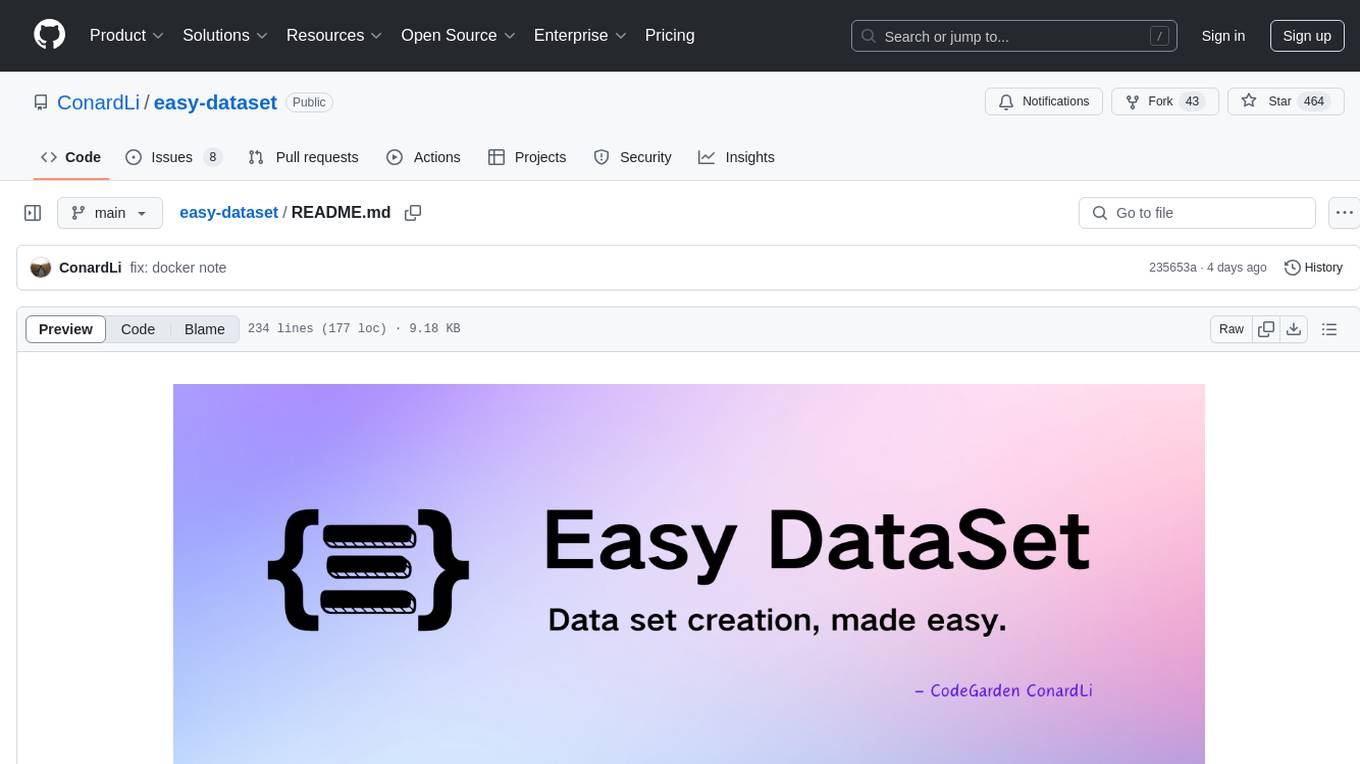
easy-dataset
Easy Dataset is a specialized application designed to streamline the creation of fine-tuning datasets for Large Language Models (LLMs). It offers an intuitive interface for uploading domain-specific files, intelligently splitting content, generating questions, and producing high-quality training data for model fine-tuning. With Easy Dataset, users can transform domain knowledge into structured datasets compatible with all OpenAI-format compatible LLM APIs, making the fine-tuning process accessible and efficient.
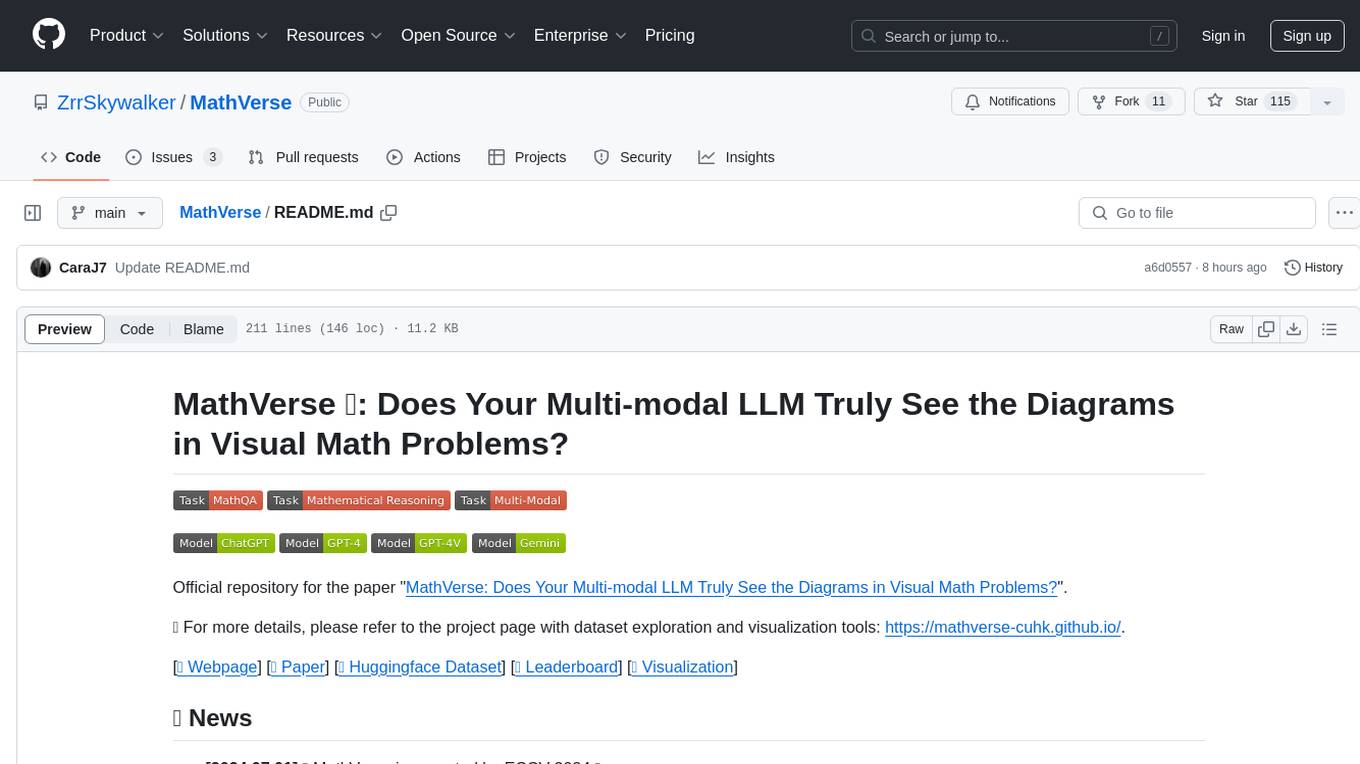
MathVerse
MathVerse is an all-around visual math benchmark designed to evaluate the capabilities of Multi-modal Large Language Models (MLLMs) in visual math problem-solving. It collects high-quality math problems with diagrams to assess how well MLLMs can understand visual diagrams for mathematical reasoning. The benchmark includes 2,612 problems transformed into six versions each, contributing to 15K test samples. It also introduces a Chain-of-Thought (CoT) Evaluation strategy for fine-grained assessment of output answers.
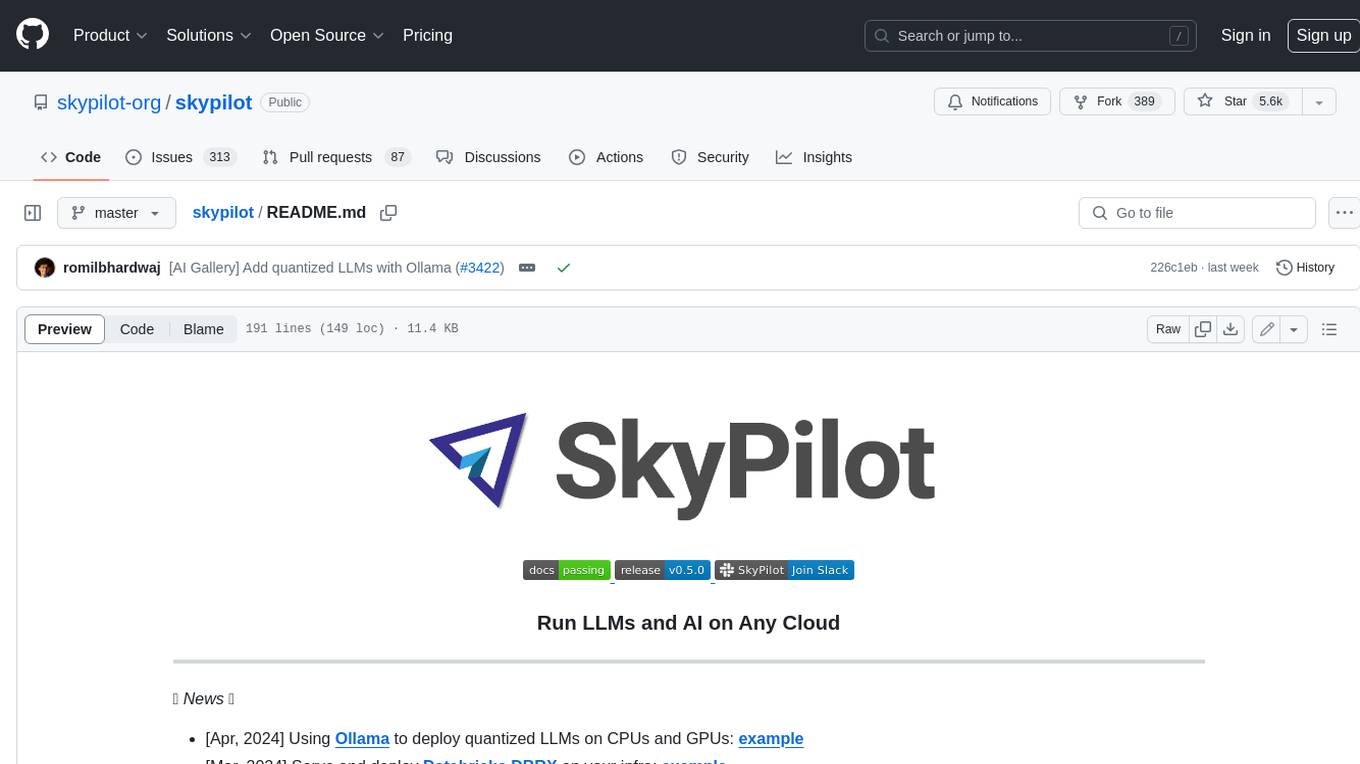
skypilot
SkyPilot is a framework for running LLMs, AI, and batch jobs on any cloud, offering maximum cost savings, highest GPU availability, and managed execution. SkyPilot abstracts away cloud infra burdens: - Launch jobs & clusters on any cloud - Easy scale-out: queue and run many jobs, automatically managed - Easy access to object stores (S3, GCS, R2) SkyPilot maximizes GPU availability for your jobs: * Provision in all zones/regions/clouds you have access to (the _Sky_), with automatic failover SkyPilot cuts your cloud costs: * Managed Spot: 3-6x cost savings using spot VMs, with auto-recovery from preemptions * Optimizer: 2x cost savings by auto-picking the cheapest VM/zone/region/cloud * Autostop: hands-free cleanup of idle clusters SkyPilot supports your existing GPU, TPU, and CPU workloads, with no code changes.
For similar tasks

SoM-LLaVA
SoM-LLaVA is a new data source and learning paradigm for Multimodal LLMs, empowering open-source Multimodal LLMs with Set-of-Mark prompting and improved visual reasoning ability. The repository provides a new dataset that is complementary to existing training sources, enhancing multimodal LLMs with Set-of-Mark prompting and improved general capacity. By adding 30k SoM data to the visual instruction tuning stage of LLaVA, the tool achieves 1% to 6% relative improvements on all benchmarks. Users can train SoM-LLaVA via command line and utilize the implementation to annotate COCO images with SoM. Additionally, the tool can be loaded in Huggingface for further usage.
Pixel-Reasoner
Pixel Reasoner is a framework that introduces reasoning in the pixel-space for Vision-Language Models (VLMs), enabling them to directly inspect, interrogate, and infer from visual evidences. This enhances reasoning fidelity for visual tasks by equipping VLMs with visual reasoning operations like zoom-in and select-frame. The framework addresses challenges like model's imbalanced competence and reluctance to adopt pixel-space operations through a two-phase training approach involving instruction tuning and curiosity-driven reinforcement learning. With these visual operations, VLMs can interact with complex visual inputs such as images or videos to gather necessary information, leading to improved performance across visual reasoning benchmarks.
For similar jobs

sweep
Sweep is an AI junior developer that turns bugs and feature requests into code changes. It automatically handles developer experience improvements like adding type hints and improving test coverage.

teams-ai
The Teams AI Library is a software development kit (SDK) that helps developers create bots that can interact with Teams and Microsoft 365 applications. It is built on top of the Bot Framework SDK and simplifies the process of developing bots that interact with Teams' artificial intelligence capabilities. The SDK is available for JavaScript/TypeScript, .NET, and Python.

ai-guide
This guide is dedicated to Large Language Models (LLMs) that you can run on your home computer. It assumes your PC is a lower-end, non-gaming setup.

classifai
Supercharge WordPress Content Workflows and Engagement with Artificial Intelligence. Tap into leading cloud-based services like OpenAI, Microsoft Azure AI, Google Gemini and IBM Watson to augment your WordPress-powered websites. Publish content faster while improving SEO performance and increasing audience engagement. ClassifAI integrates Artificial Intelligence and Machine Learning technologies to lighten your workload and eliminate tedious tasks, giving you more time to create original content that matters.

chatbot-ui
Chatbot UI is an open-source AI chat app that allows users to create and deploy their own AI chatbots. It is easy to use and can be customized to fit any need. Chatbot UI is perfect for businesses, developers, and anyone who wants to create a chatbot.

BricksLLM
BricksLLM is a cloud native AI gateway written in Go. Currently, it provides native support for OpenAI, Anthropic, Azure OpenAI and vLLM. BricksLLM aims to provide enterprise level infrastructure that can power any LLM production use cases. Here are some use cases for BricksLLM: * Set LLM usage limits for users on different pricing tiers * Track LLM usage on a per user and per organization basis * Block or redact requests containing PIIs * Improve LLM reliability with failovers, retries and caching * Distribute API keys with rate limits and cost limits for internal development/production use cases * Distribute API keys with rate limits and cost limits for students

uAgents
uAgents is a Python library developed by Fetch.ai that allows for the creation of autonomous AI agents. These agents can perform various tasks on a schedule or take action on various events. uAgents are easy to create and manage, and they are connected to a fast-growing network of other uAgents. They are also secure, with cryptographically secured messages and wallets.

griptape
Griptape is a modular Python framework for building AI-powered applications that securely connect to your enterprise data and APIs. It offers developers the ability to maintain control and flexibility at every step. Griptape's core components include Structures (Agents, Pipelines, and Workflows), Tasks, Tools, Memory (Conversation Memory, Task Memory, and Meta Memory), Drivers (Prompt and Embedding Drivers, Vector Store Drivers, Image Generation Drivers, Image Query Drivers, SQL Drivers, Web Scraper Drivers, and Conversation Memory Drivers), Engines (Query Engines, Extraction Engines, Summary Engines, Image Generation Engines, and Image Query Engines), and additional components (Rulesets, Loaders, Artifacts, Chunkers, and Tokenizers). Griptape enables developers to create AI-powered applications with ease and efficiency.


